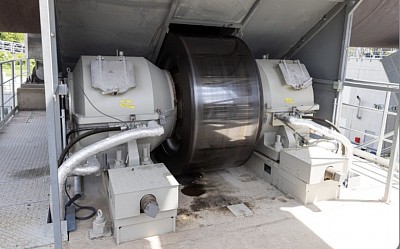INTRODUCTION: ROTARY KILNS & TRUNNION ROLLER SERVICES
Rotary kilns and Rollers endure rigorous conditions, including high temperatures, dust, chemical exposure, mechanical strain, and prolonged operational periods throughout their lifespan.
When the rotary kiln operates in this condition for some time, the tire will have accelerated wear on its edges,
giving it a convex shape. The support rollers are wider than the tire hence the surface of the rollers will develop
concave wear. Since this is the desired adjustment position of the rollers to control the axial thrust of the kiln,
this kiln design makes concave and convex wear inevitable.
Common Issues:
Increased shell vibrationsExcessive load on the drive mechanismDamage to rotary kiln inlet and outlet sealsHot bearingsPremature refractory lining failureCracked foundation padsIncreased wear and damage on the Girth Gear
Repairing Of Trunnion Roller:
Skewing on trunnion rollers refers to a deliberate adjustment made to the orientation of the rollers in relation to the axis of the rotary kiln or dryer. This adjustment involves tilting the trunnion rollers slightly off-center, either horizontally or vertically, to compensate for various operational factors and ensure optimal performance of the equipment.
Here's an explanation of skewing and its significance:
Purpose of Skewing: Skewing is primarily employed to counteract the effects of thermal expansion, mechanical stresses, and other factors that may cause the rotary kiln or dryer to deviate from its ideal alignment during operation. By strategically adjusting the position of the trunnion rollers, skewing helps maintain proper contact between the kiln/dryer shell and the support rollers, promoting even weight distribution and reducing the risk of premature wear or damage
Horizontal Skewing: In horizontal skewing, the trunnion rollers are adjusted laterally to compensate for any misalignment or deflection of the kiln/dryer shell. This helps prevent excessive contact forces and uneven loading on the support rollers, minimizing wear and prolonging their service life.
Vertical Skewing: Vertical skewing involves tilting the trunnion rollers upward or downward to maintain proper contact between the kiln/dryer shell and the support rollers along the vertical axis. This adjustment helps counteract the effects of thermal expansion or contraction, ensuring consistent kiln/dryer alignment and reducing the risk of shell distortion or misalignment.
Skewing Mechanisms: Skewing of trunnion rollers can be achieved using various mechanical or hydraulic mechanisms, depending on the design and configuration of the rotary kiln or dryer:
Mechanical Adjustment: Some kiln/dryer systems are equipped with manual or automated mechanisms that allow for precise adjustment of the trunnion roller positions. These mechanisms may include shims, wedges, or eccentric bushings that enable fine-tuning of the skewing angle as needed.
Hydraulic Skewing Systems: In larger or more sophisticated kiln/dryer installations, hydraulic skewing systems may be employed to facilitate dynamic adjustment of the trunnion roller positions during operation. These systems utilize hydraulic actuators or cylinders to control the skewing angle in real time, allowing for precise alignment correction and optimization of equipment performance.
Overall, skewing on trunnion rollers plays a crucial role in maintaining the stability, alignment, and efficiency of rotary kilns and dryers, ensuring smooth operation and extending the service life of critical components.
Precision Grinding: Using specialized grinding equipment and techniques, the bearing surfaces of the trunnion rollers are carefully ground to remove material and achieve the desired dimensional accuracy and surface finish. This process may involve cylindrical grinding, surface grinding, or other precision grinding methods to achieve tight tolerances and smooth finishes.
Surface Protection: To enhance durability and prolong the WearLife of the regrinded surfaces, protective coatings or treatments may be applied to provide corrosion resistance, lubrication, or other beneficial properties.
Thermal Spraying: Thermal spraying involves applying a layer of molten or semi-molten material onto the surface of the trunnion rollers using a high-temperature thermal spray gun. Materials such as metal alloys, ceramics, carbides, and composites can be sprayed onto the substrate to form a hard and wear-resistant coating. Thermal spraying offers excellent adhesion, uniform coverage, and versatility in coating selection to meet specific wear challenges.
Ceramic Coatings: Ceramic coatings are composed of ceramic particles suspended in a matrix of binder material, which is applied to the surface of the trunnion rollers through spraying, dipping, or brushing. Ceramics offer exceptional hardness, thermal stability, and resistance to wear, making them well-suited for high-temperature applications. Ceramic coatings can withstand abrasive wear, thermal cycling, and chemical exposure, providing long-lasting protection for trunnion rollers in harsh environments.
Tungsten Carbide Thermal Spray: Tungsten carbide thermal spray coatings consist of tungsten carbide particles embedded in a metal matrix, which is applied to the surface of the trunnion rollers using thermal spraying techniques. Tungsten carbide is renowned for its exceptional hardness, wear resistance, and toughness, making it ideal for protecting trunnion rollers against abrasive wear and impact loading. Tungsten carbide coatings can withstand extreme operating conditions and provide long-lasting wear protection in demanding applications.
By applying these enhanced surface treatments to trunnion rollers, industrial operators can significantly increase their WearLife, reduce maintenance costs, and prolong the service life of rotary kilns and dryers. The selection of the appropriate surface treatment depends on factors such as operating conditions, wear mechanisms, and performance requirements, and should be carefully evaluated to ensure optimal results.

